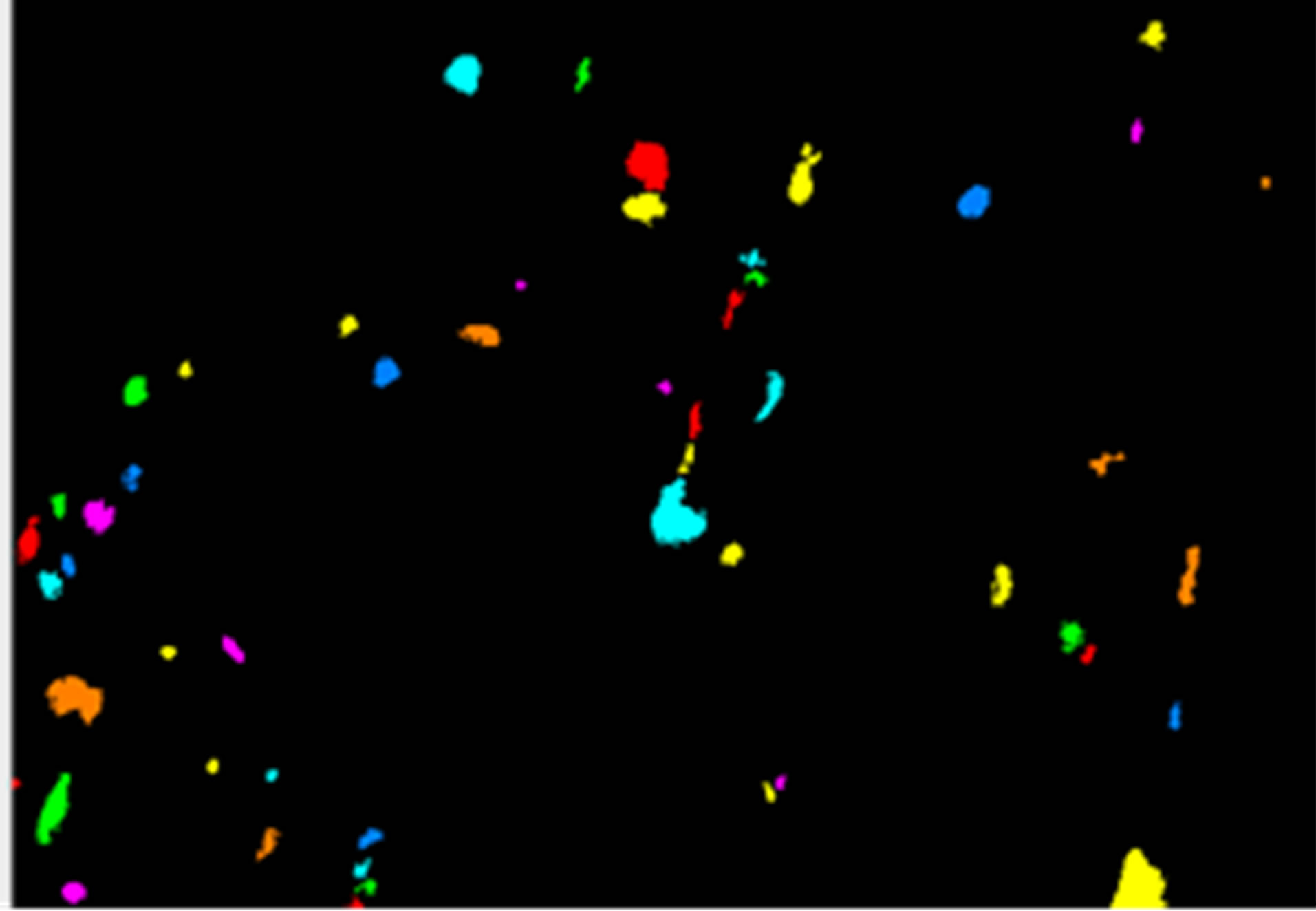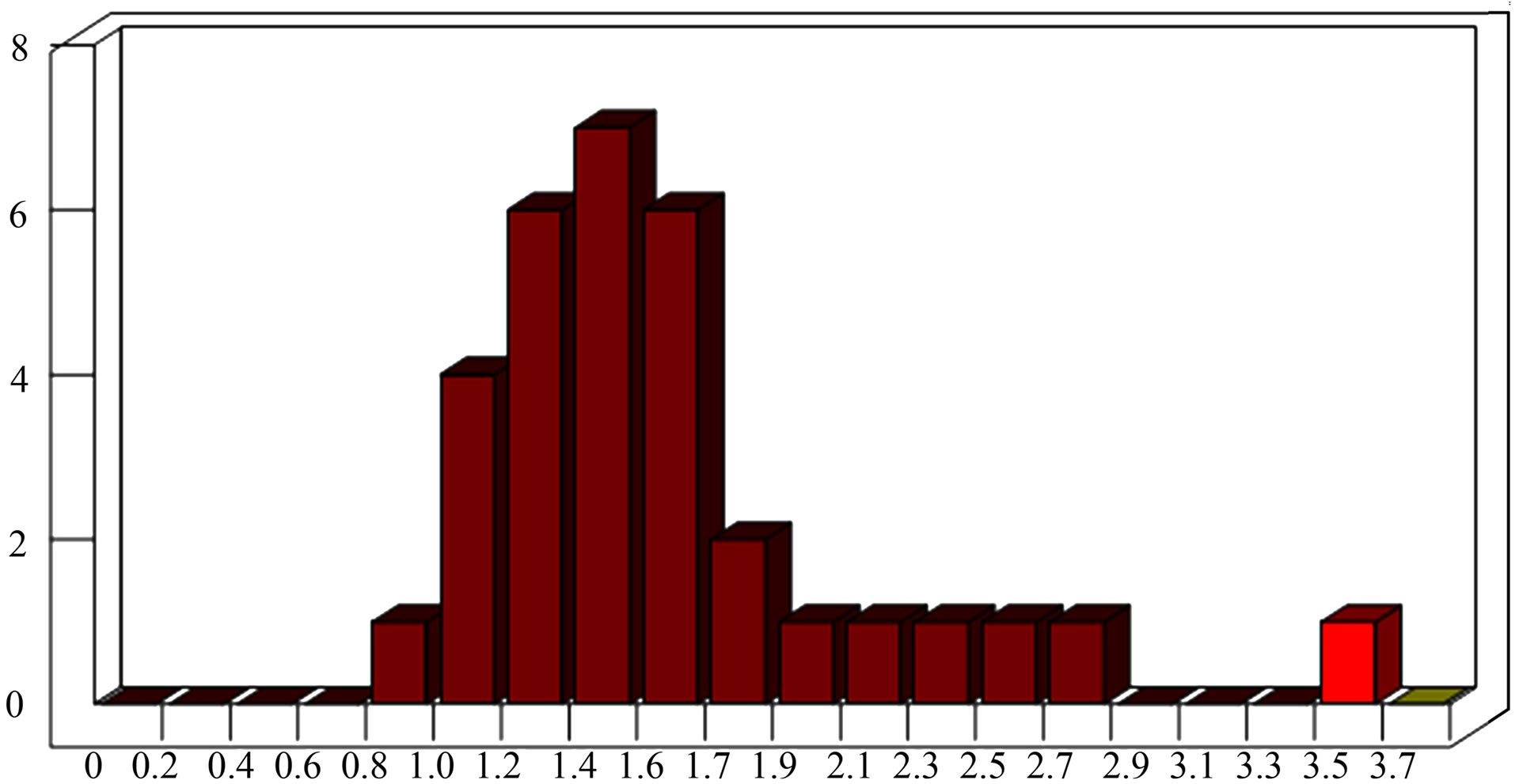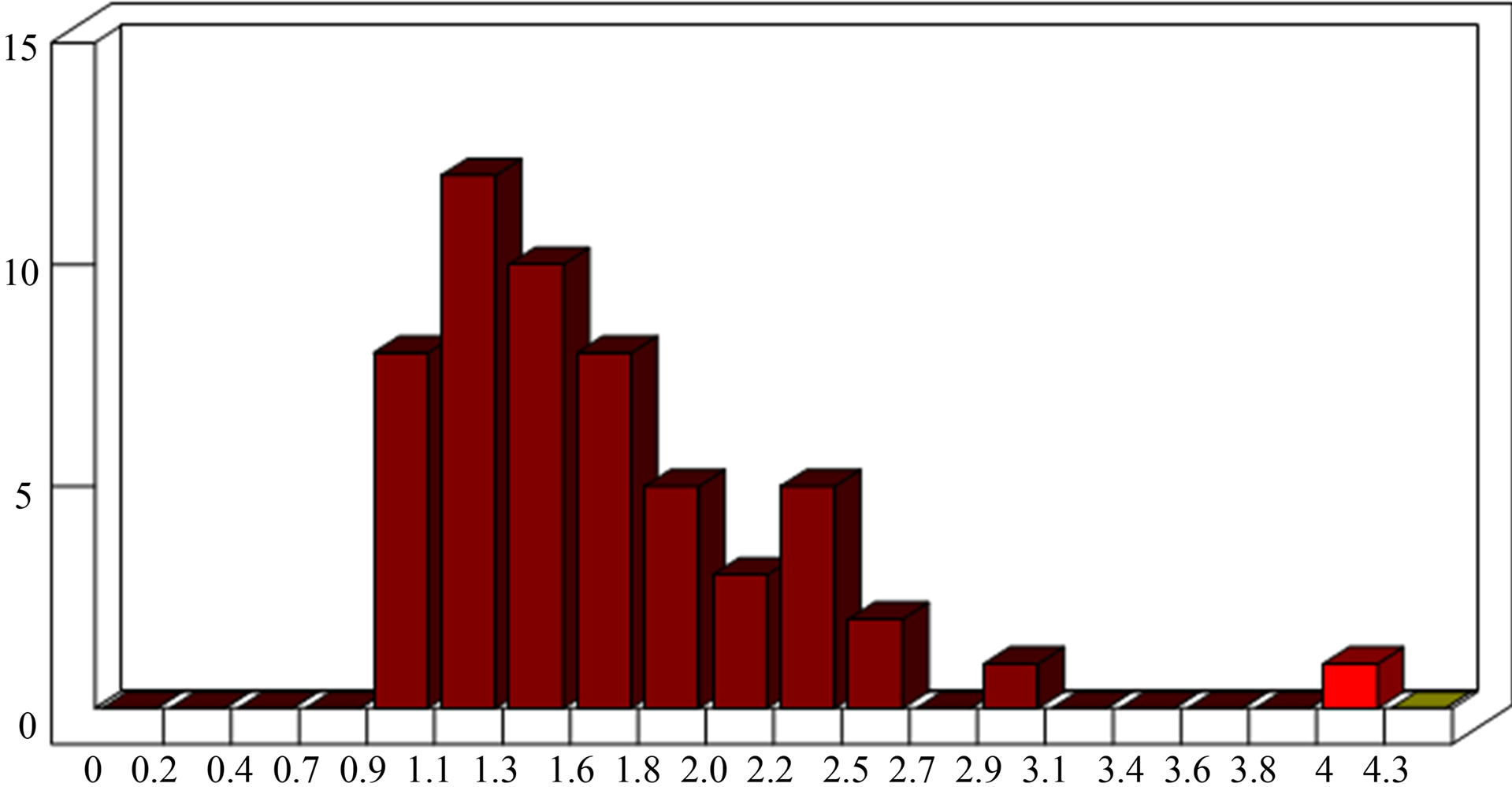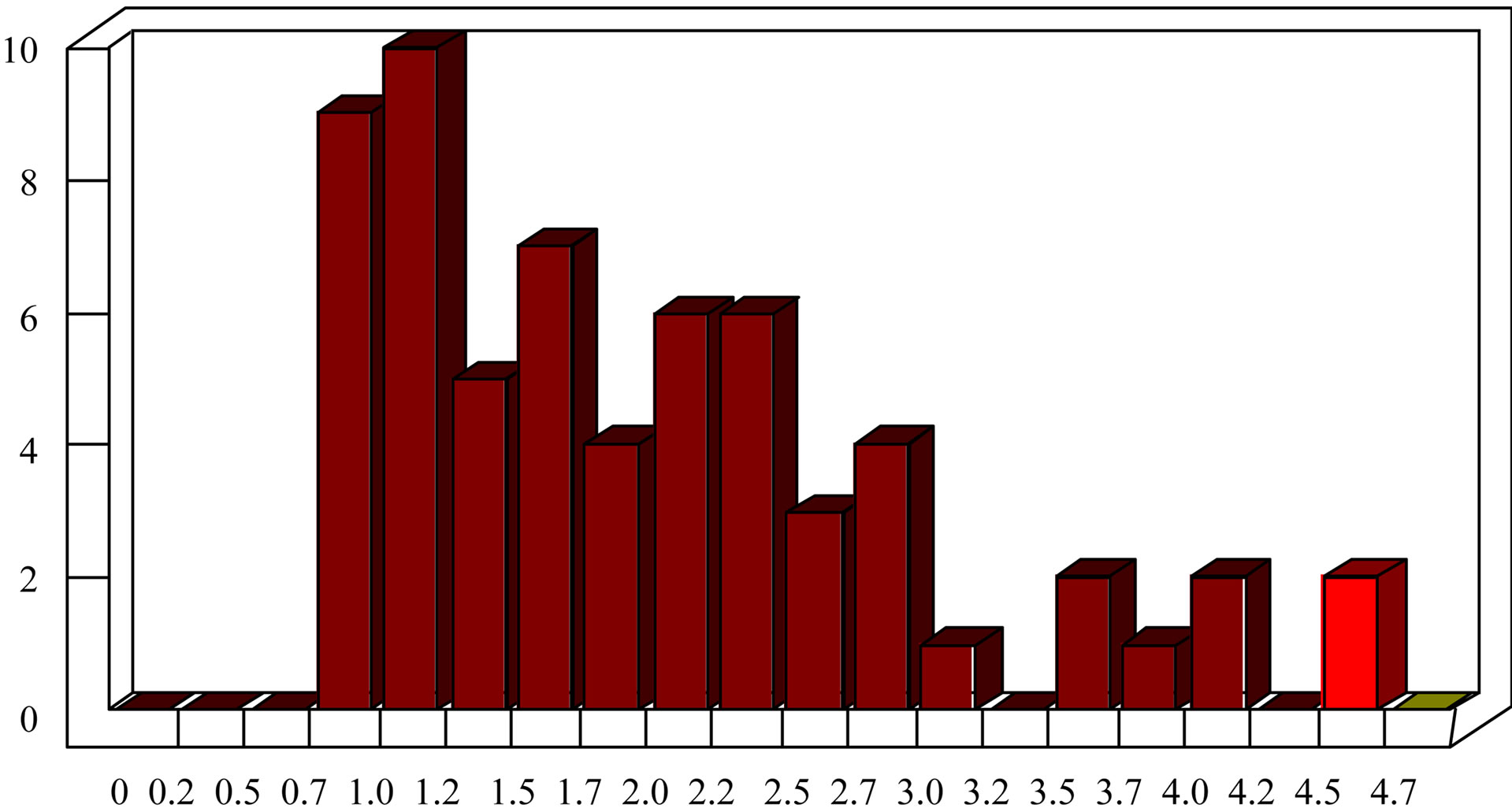Journal of Analytical Sciences, Methods and Instrumentation
Vol.2 No.1(2012), Article ID:17814,4 pages DOI:10.4236/jasmi.2012.21006
Single-Particle Analysis in an Indoor Working Environment in Valencia, Spain
![]()
1Departamento de Construcciones Arquitectónicas, Universidad Politécnica de Valencia, Valencia, España; 2Departamento de Física Aplicada, Universidad Politécnica de Valencia, Valencia, España.
Email: jllinares@csa.upv.es
Received January 25th, 2012; revised February 15th, 2012; accepted February 29th, 2012
Keywords: Air Quality; Indoor Air; SEM-EDX; Particle Analysis; Cluster Analysis
ABSTRACT
Actually is recognized the importance of indoor air environment and associated health risks. In order to evaluate indoor air quality and to characterize the particles in terms of size, composition and shape were done measurements of the suspended particulate matter in a mechanical workshop of the Polytechnic University of Valencia (Spain). These measurements were performed using scanning electron microscope (SEM) with energy dispersive X-ray microanalysis (EDX) and image digital analysis. To differentiation of individual particles in the fine-ultrafine fraction, in some case, was used the atomic force microscopy (AFM). Multivariate statistics, such as hierarchical cluster analysis and factor analysis were appliqued and allowed to establish groups of elements and in this way to facilitate the identification of the natural and anthropogenic sources. It is confirmed that indoor air is influenced by outdoor surroundings and the anthropogenic sources due to the daily activity.
1. Introduction
The health effects of particulate matter have been extensively studied. The harmful effects of particles are dependent on certain characteristics such as the chemical composition and microphysical properties of individual particles, justifying the use of single-particle analysis [1-4]. Particle size is an important factor regarding the health problems by particulate matter as it determines the site of deposition in the respiratory tract [5,6] and also the ultafine particles would be distributed into the cardiovascular system [7]. Altought adverse health effects of particulate matter are mostly attributed to finer fractions, only smaller particles reach the deepest region of the lungs, however it has demonstrated that ambient coarse particles may also have negative effects therefore that both coarse and fine particles represent a risk to health although with different adverse effects [8]. The determination of elemental composition of particles is necessary to obtain a complete knowledge, as possible, of their chemical composition.
It is generally accepted that indoor concentration of particles derive from two sources: indoor and outdoor. Although numerous measurements in the outside air have been conducted, only few data on indoor air pollution are available. Until recently, the health effects of indoor air pollution have received relatively little attention and much less is know in indoor working environments [9, 10]. In recent years, people have started to recognize the importance of indoor air environment. This paper presents a study of particulate matter in an indoor working atmosphere of Polytechnic University of Valencia (Spain) to obtain knowledge about their air quality. The size, shape and chemical composition of particles are discussed here. The inter-elemental relationships were determined with statistical methods. That will proportioned valuable information for the identification of major emission sources of particulate matter.
2. Experimental
2.1. Sampling Site
The sampling was done in a mechanical workshop of Polytechnic University of Valencia no air conditioning system was in use. Valencia is a city located at the Spanish Mediterranean coast and the Polytechnic University is close to the sea and, hence, exposed to a marine environment, with proximity of the motorways and agricultural growing.
2.2. Analysis
Suspended particles were collected via a size-fractionating cascade impactor, the MPS-3 of Schaefer Techniques with three size cut-off stages. Particles were collected on aluminum plates. The size ranges, which are based on aerodynamic equivalent diameters for the impactor are: particles larger than 2 µm (stage 1) of 2 - 0.3 µm (stage 2) and of 0.3 - 0.05 µm (stage 3), in this work named as “coarse”, “medium” and “small” respectively. Air drawn by means of a pump is forced to circulate through the system at a constant flow rate about 2 l/min. The duration of each sampling was of few min because overlapping of particles is likely to occur for high sample loadings and to cause errors in the selection of individual particles.
The particles were analyzed by a computer-controlled SEM-EDX. The determination of elemental composition of individual particles and of their morphology was done by image digital analysis with Imquant software of Oxford Isis. The SEM used was a JSM-6300 operating in mode emissive at 20 kV. Was used a silicon detector that determine elements with atomic numbers greater than bore. The aluminum plates can be placed in the SEM without previous manipulation, and were stored into a desiccator at room temperature (silica gel with humidity indicator) before of your observation in SEM. The samples were covered by a layer of carbon for converting in conductor samples. Particle images acquired during the computer-controlled analyses played a key role in the identification. To fix the morphologic limits of particles was used, on backscattered electron images, the grey level thresholds and each image was converted into a binary image allowing for the automatic detection of particles. Of each particle was evaluated the area, perimeter and shape. X-ray spectra of the particles were acquired for 20 s of live time.
To differentiation of individual particles when are very close to each other or in the “small” fraction, in some case, was used the atomic force microscopy (AFM). The AFM measurements were performed by Nanoscope III from Digital Instruments Inc. Samples for AFM were directly analizated without pretreatments. The AFM is a powerful tool for the characterization allowing to obtain fundamental parameters of morphology and the number of particles per aggregate.
2.3. Statistical Analysis
To classify and establish possible sources the data were statistically treated mainly by cluster analysis using as variables the standardized values of the elements. Centroid method was used, being the measure of similarity the squared Euclidean distance. Was used the SPSS version 16 statistical software.
3. Results and Discussion
The Figure 1 shows a image processed by the Imquant software.

Figure 1. Binary image for stage 2.
3.1. Area, Perimeter and Shape of Particles
Mean area for the different stages have been 15.30, 0.82 and 1.06 µm2, and the perimeter 14.90, 3.72 and 4.58 µm respectively. According to previous results, was observed that particles of stage 3 tend to form aggregates and cannot be individually analyzed to respect at their morphology. Accordingly, very little of the particulate matter remains in the very small size. The use of AFM, at ambient conditions (temperature and pressure), has permitted the observation of these aggregates and their separation, in certain cases, in single particles and to obtain the number of particles per aggregate.
Figures 2-4 show the frequency versus area of particles for the stage 1, stage 2 and stage 3 respectively.
Figures 5-7 show frequency versus shape for stages 1, 2 and 3 respectively. Value 1 corresponds to spherical particle.
3.2. Chemical Composition of Particles
X-ray spectra were collected of each particle including the particles (or aggregates) of stage 3. From the analytical data obtained with Imquant software, it must be noted, negative concentrations were set to zero. For individual elements, the patterns of concentrations across stage 1 and stages 2 and 3 vary considerably. The results of the study revealed for stage 1 the presence of Na, Mg, Si, Al, S, Cl, K, Ca, Ti, Cr, Fe, Ni and Cu. For stages 2 and 3 the presence mainly of elements Si, S, Cr, Fe, Ni and Cu. For the stages 2 and 3 particle number decreased significantly.
In the stage 1 was found that Si is the major element and other abundant elements are Ca, S and Cl, last one would be expected in a coastal city.
The statistical techniques, such as hierarchical cluster analysis and factor analysis were appliqued to the elemental composition data in order to verify the presence of compositional groups that were contrasted with the real possibilities obtained from a particle atlas [11], allowed to

Figure 2. Stage 1.

Figure 3. Stage 2.

Figure 4. Stage 3.

Figure 5. Stage 1.

Figure 6. Stage 2.

Figure 7. Stage 3.
establish groups of elements and in this way to facilitate the identification of the natural and anthropogenic sources.
4. Conclusions
On the basis of the data collected, the so-called coarse particles have a very important contribution of ground dust, which is composed mainly by silicates, some carbonate particle and gypsum. Other source found is sea spray (sodium chloride). As in similar studies in Polytechnic University of Valencia classrooms have not been found elements like Cr, Ni and Cu, they should correspond to the use of alloys in mechanical workshop activity. It is considered that in this fraction the indoor air is greatly influenced by outdoor surroundings.
The chemical components relating to anthropogenic sources caused by the activity in mechanical workshop are observed to accumulate mainly in the “medium” and “small” fractions. Therefore, although the number of particles is very small, given its size it is important to control their emission to prevent health problems.
Some limitations have to be taken into account like the impossibility of determining carbonaceous particles since that the samples were covered by a layer of carbon for converting in conductor samples and the difficulty to discriminate particles in certain cases.
5. Acknowledgements
The authors appreciate the assistance of Electron Microscopy Service of the Common Services of the Polytechnic University of Valencia.
REFERENCES
- R. M. Harrison and J. X. Yin, “Particulate Matter in the Atmosphere: Which Particle Properties Are Important for Its Effects on Health,” The Science of the Total Environment, Vol. 249, No. 1-3, 2000, pp. 85-101. doi:10.1016/S0048-9697(99)00513-6
- P. Penttinen, K. L. Timonen, P. Tiittanen, A. Mirme, J. Ruuskanen and J. Pekkenen, “Ultrafine Particles in Urban Air and Respiratory Health among Adult Asthmatics”, European Respiratory Journal, Vol. 17, No. 3, 2001, pp. 428-435. doi:10.1183/09031936.01.17304280
- G. S. Casuccio, S. F. Schlaegle, T. L. Lersch, G. P. Huffman, Y. Chen and N. Shah, “Measurement of Fine Particulate Matter Using Electron Microscopy Techniques,” Fuel Processing Technology, Vol. 85, No. 6-7, 2004, pp. 763-779. doi:10.1016/j.fuproc.2003.11.026
- M. Choël, K. Deboudt, P. Flament, L. Aimoz, and X. Mériaux, “Single-Particle Analysis of Atmospheric Aerosols at Cap Gris-Nez Channel: Influence of Steel Works on Iron Apportionment,” Atmospheric Environment, Vol. 41, No. 13, 2007, pp. 2820-2830. doi:10.1016/j.atmosenv.2006.11.038
- C. Monn, “Exposure Assessment o Fair Pollutants: A Review on Spatial Heterogeneity and Indoor/Outdoor Personal Exposure to Suspended Particulate Matter, NO2 and O3,” Atmospheric Environment, Vol. 35, No. 1, 2001, pp. 1-32. doi:10.1016/S1352-2310(00)00330-7
- U. Franck, O. Herbarth, S. Röder, U. Schlink, M. Borte, U. Diez, U. Krämer and I. Lehmann, “Respiratory Effects of Indoor Particles in Young Children Are Size Dependent,” Science of the Total Environment, Vol. 409, No. 9, 2011, pp. 1621-1631. doi:10.1016/j.scitotenv.2011.01.001
- G. Nalbone, “Pollution Par les Particules Atmosphériques Fines et Ultrafines et Risque Cardiovasculaire,” Médecine & Longévité, Vol. 2, 2010, pp. 22-39
- EPAQS, “Airborne Particles,” Expert Panel on Air Quality Standards, London, 2001.
- M. Žitnik, A. Kastelic, Z. Rupnik, P. Pelicon, P. Vaupetič, K. Bučar, S. Novak, Z. Samardžija, S. Matsuyama, G. Catella and K. Ishii, “Time-Resolved Measurements of Aerosol Elemental Concentrations in Indoor Working Environments,” Atmospheric Environment, Vol. 44, No. 38, 2010, pp. 4954-4963. doi:10.1016/j.atmosenv.2010.08.017
- M. Lisiewicz, R. Heimburger and J. Golimowski. “Granulometry and the Content of Toxic and Potentially Toxic Elements in Vacuum-Cleaner Collected, Indoor Dusts of the City of Warsaw,” The Science of The Total Environment, Vol. 263, No. 1-3, 2000, pp. 69-78. doi:10.1016/S0048-9697(00)00667-7
- The Particle Atlas PAE2, McCrone Research Institute.

